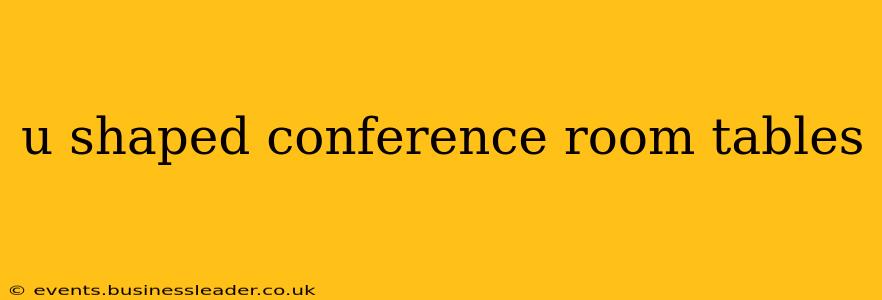U-shaped conference room tables are a popular choice for meetings and collaborative work, offering a unique blend of functionality and visual appeal. Their design facilitates interaction and communication while maintaining a professional and organized workspace. This comprehensive guide delves into the various aspects of U-shaped conference tables, helping you determine if they're the right fit for your needs.
What are the Benefits of a U-Shaped Conference Table?
The U-shape design offers several key advantages over traditional rectangular or round tables. It fosters a more inclusive and collaborative environment, promoting open communication and equal participation among attendees. The open, central space allows for easy access to presentations, shared documents, or equipment, eliminating the need to pass items across the table. Furthermore, the configuration naturally encourages eye contact and engagement between participants, fostering a more dynamic and productive meeting experience.
What are the Different Types of U-Shaped Conference Tables?
U-shaped conference tables come in a variety of materials, sizes, and styles to suit diverse office environments and preferences. Common materials include wood (like mahogany or oak), laminate, metal, and glass. The size will depend on the typical number of attendees, ranging from small tables accommodating six to eight people to large tables capable of seating twenty or more. Some tables also incorporate features like built-in power outlets, data ports, and cable management systems for increased convenience and organization. Consider the overall aesthetic of your office when choosing a style – modern, traditional, or minimalist designs are all available.
How Much Space Do I Need for a U-Shaped Conference Table?
The space required for a U-shaped conference table depends largely on its size and the desired amount of legroom for attendees. As a general rule, allow for at least 24-30 inches of space per person along the straight sides of the U and slightly more along the curved portion for comfortable seating. Additionally, ensure sufficient space around the table for easy movement and access. Consider measuring the available space before purchasing a table to avoid overcrowding or insufficient room.
How much space do I need for a U-shaped conference table with 10 people?
For a 10-person U-shaped table, you should allow approximately 240-300 inches (20-25 feet) of total table length, accounting for the three sides. Add to this the space needed around the table for comfortable movement and access, which might require an extra 3-4 feet on each side. This gives you a minimum space requirement of around 26-33 feet. However, the actual dimensions will vary depending on the specific table design and the desired legroom.
What is the ideal size for a U-shaped conference table?
The ideal size depends entirely on your needs. Consider the average number of attendees at your meetings, and the amount of space each person needs comfortably. Measure your space and consult dimensions provided by vendors to ensure a proper fit. Remember to factor in any additional space needed for presentations or equipment. A good rule of thumb is to avoid cramming participants together – prioritize comfort and ease of collaboration.
Where should I place a U-shaped conference table in my conference room?
The placement of your U-shaped conference table should optimize accessibility and visual impact. Ideally, position the table such that natural light enhances visibility for all attendees. Avoid placing the table directly in front of a window, unless the window offers minimal glare. Consider the orientation of the room and the location of any presentation equipment or technology. Good placement ensures everyone feels comfortable and included.
What are the Disadvantages of U-Shaped Conference Tables?
While U-shaped tables offer many advantages, there are some potential drawbacks to consider. The design can be less flexible than a rectangular table, making it less suitable for meetings with varying attendance numbers. They also tend to occupy a larger floor area than rectangular or round tables, a potential issue in smaller conference rooms. Finally, the curved shape can make it slightly more challenging to arrange seating for specific participants or groups.
Conclusion
U-shaped conference tables provide a unique and effective solution for businesses seeking to foster collaboration and open communication. By carefully considering the benefits, disadvantages, and space requirements, you can choose a U-shaped conference table that perfectly suits your meeting room and enhances productivity. Remember to prioritize comfort, accessibility, and the overall aesthetic appeal when making your decision.
